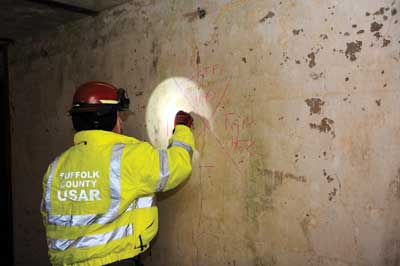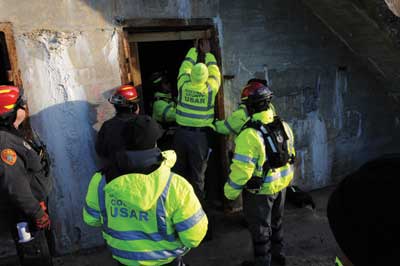<Previous Displaying 2/2 Page 1, 2
View Article as Single page
SEARCH AND RESCUE
To increase their effectiveness, the search and rescue specialists were notified of the MobEx site and were encouraged to learn more about Plum Island. This would help to place the specialists in the proper frame of mind for seaborne operations and wide-area search methods for devastated communities. This also helped to dispel any misconceptions about Plum Island and what goes on there. Note that no task force members refused to participate in the MobEx as a result of rumors heard or misconceptions held about the animal disease research facility.
For the search squads and K-9 teams, the island itself presented the best challenges. Although there was only one main road, multiple unmarked secondary roads and paths branching off it led to multiple reinforced concrete bunkers and gun emplacements and two unlabeled rubble piles. All of these sites would require detailed searches, identification, and designation by search squads and K-9 teams for the rescue squads and other personnel who would follow (photo 4). Sound-emanating devices hidden among the debris simulated trapped victims, in addition to the dozen trapped victims (manikins and live) located throughout the fictitious communities.

For the rescue squads, the facilitators established multiple scenarios with live victims and manikins needing rescue. The scenarios included a low-angle rescue from the beach (photo 5), a high-angle rescue from a two-story platform, a shoring operation (photo 6), a confined-space rescue, and the rescue of a victim trapped in rubble. The rescue squads would rely on the search squads to identify the locations requiring specialized rescue and the logistics branch to provide the resources and transportation to the affected sites.


THE EXERCISE
With the exercise design in place, the SC USAR TF could begin to develop its 24-hour TAP. Starting on Friday evening (before deployment), all participating task force members were alerted to call in for assignment. Simultaneously, the task force leader (TFL) and planning branch began assigning members to the positions in the organizational chart. Logistics would also begin checking the cache and preparing the vehicles for deployment. On Saturday, the SC USAR TF mobilized at 0500 hours and departed at 0530 hours by land transport. By 0700 hours, the first wave of task force personnel and equipment were aboard the ferry and en route to Plum Island. At 0800 hours, the TFL, the rescue branch manager, the planning branch manager, the logistics manager, and the medical specialist were inbound by helicopter and conducting aerial reconnaissance. By 0900 hours, the BoO was established and the search squads were deployed.
Based on the reconnaissance missions and the intelligence provided by fictitious Plum Island residents, the rescue squads were deployed. By 1545 hours, all victims were rescued and transported by boat to Long Island, where they were transported to an area hospital. By 1645 hours, with the onset of nightfall, all squads were recovered and were debriefed by the TFL and the planning branch. The logistics and planning branches developed plans for the next day’s missions as well as outlined the breakdown and departure process and the units’ order of departure from Plum Island. By 1830 hours, the task force members were out of the elements, eating dinner, and settling in for the overnight rest period.
At 0600 hours on Sunday, the task force began to break down the sleeping encampment and preparing for the second day’s operational period. By 0730 hours, however, Plum Island security notified the TFL and planning branch that gale force winds were expected within the next few hours. As a result, the Plum Island ferryboat captain recommended immediate departure of all task force members. This was much earlier than was originally anticipated and would not allow for the search evolutions setup for Sunday. The original planned phased departure was to begin at 1200 hours. Unfortunately, the gale force winds would create high seas for the next 10 to 12 hours, and with the task force vehicles aboard, the ferryboat could not operate safely in such conditions. The TFL and his staff decided to begin “bug-out” (emergency departure) procedures. Once again, the planning and logistics branches’ development of a departure process paid off. Starting at 0800 hours, the task force began bug-out operations. By 1100 hours, all task force members and equipment were off Plum Island as weather conditions deteriorated. By 1400 hours, all task force assets were back at the PoD, and the demobilization was completed.
LESSONS LEARNED
Overall, the 2013 MobEx was a great success; thanks to the Plum Island staff, who helped create a great exercise experience. As always, our “lessons learned” were numerous. Some critical lessons are highlighted below.
Assignments. Although the task force members have worked incidents together and were confident of each other’s capabilities, during an incident they do not have the opportunity to bond as individual squads. This may not seem critical to the overall operation, but if you are going to share close quarters in a tent it helps to know the personnel preferences of the individuals to be assigned to a squad, which is especially important when members are exhausted and require rest. Unfamiliarity with individual personnel traits will affect the squad’s productivity for the next operational period.
To address this and related issues, it was recommended that all task force members be notified of their organizational assignments before developing the TAP. This would not be easy during an actual incident because most task force members come from the volunteer organizations and their availability constantly varies. But for MobEx member assignments, the participants are known well in advance and squads can be established prior to mobilization. Because the task force trains as it would fight, the planning branch prefers to practice assigning personnel to squads during the call-in phase and then notify members of their squad assignments as they arrive at check-in. But for exercise purposes, this function will be reevaluated.
Continuous planning. This was the best lesson learned. Although the MobEx was cut short by unforeseen weather conditions, the bug-out procedure was a valuable test of the SC USAR TF ability to pack up and relocate on short notice if necessary. The work of the logistics branch manager and his staff to continue improving the load-up process even after the setup was completed allowed for rapid and effective departure from Plum Island. This was extremely important because of the limited room on ferries, the sea conditions, and the tides. It was critical for logistics to work directly with the ferry crews and leave the sea transport to the professionals. They know the tides, the currents, the winds, and how to gauge the best methods for moving resources. Similar to aircraft load masters, the ferry crew knew how and where to place equipment and apparatus to properly balance the load. This was an especially well-learned lesson because of the multiple moving parts involved-55 members and all their gear under diminishing weather conditions-and no injuries were noted. Overall, the safety and the medical staff recorded no injuries. There were two flat tires during transport, which the task force members quickly handled.
Limited ground vehicle availability during operational periods. This resulted from requests for personnel who had to travel some distance with their equipment to respond. The vehicles did not always return immediately on fulfilling the requests. To correct this, the use of transport vehicles must be tightly controlled-this is an ongoing process. Logistics controls the equipment cache and the vehicle transport. The primary vehicles for troop and equipment movement are two all-terrain vehicles and two four-wheel-drive tow vehicles. Logistics must maintain strict control of these vehicles for effective transport and vehicle access for potential real-world emergencies.
Communications. Beyond line-of-sight issues were among the most important because the reinforced belowgrade structures interfered with the operation of the 800-mhz portable radios used. Overcoming this problem required either placing personnel at the highest points to establish line of sight with the BoO or placing personnel in a relay position to maintain line of sight between the BoO and the rescue site. Other solutions being considered include deploying additional satellite phones and additional radio bands. But the written word is still one of the most effective although time-consuming methods. Because logistics will control transport vehicles, simple written request and situational reports to the command staff can be ferried back and forth by logistics transport operators.
The use of interoperability systems. Multiple-frequency radio traffic over multiple systems required using interoperability systems. Although this is useful in immediately notifying as many personnel as possible of serious conditions, the interoperability systems create a greater volume of radio traffic over all frequencies. We need to develop protocols for when to switch the interoperable radio systems on and off.
The future annual MobEx designs will continue to grow and incorporate additional exercise concepts, such as tabletop evolutions. These methods will help to ensure the readiness and preparedness of all SC USAR TF members for the next catastrophic incident response.
BRETT M. MARTINEZ has been a fire marshal in Suffolk County, New York, since 1990. He joined the fire service in 1983 as a member of the Hauppauge (NY) Fire Department. He has an associate degree in fire science from Suffolk County Community College. He is a NY-certified level II fire investigator, a level I instructor, a peace officer, and an ATF-certified accelerant detection canine handler. He is a National Incident Management System qualified Plans Section chief. He is the author of Multiple Fire Setters: The Process of Tracking and Identification (Fire Engineering, 2002).
<Previous Displaying 2/2 Page 1, 2
View Article as Single page
Fire Engineering Archives

